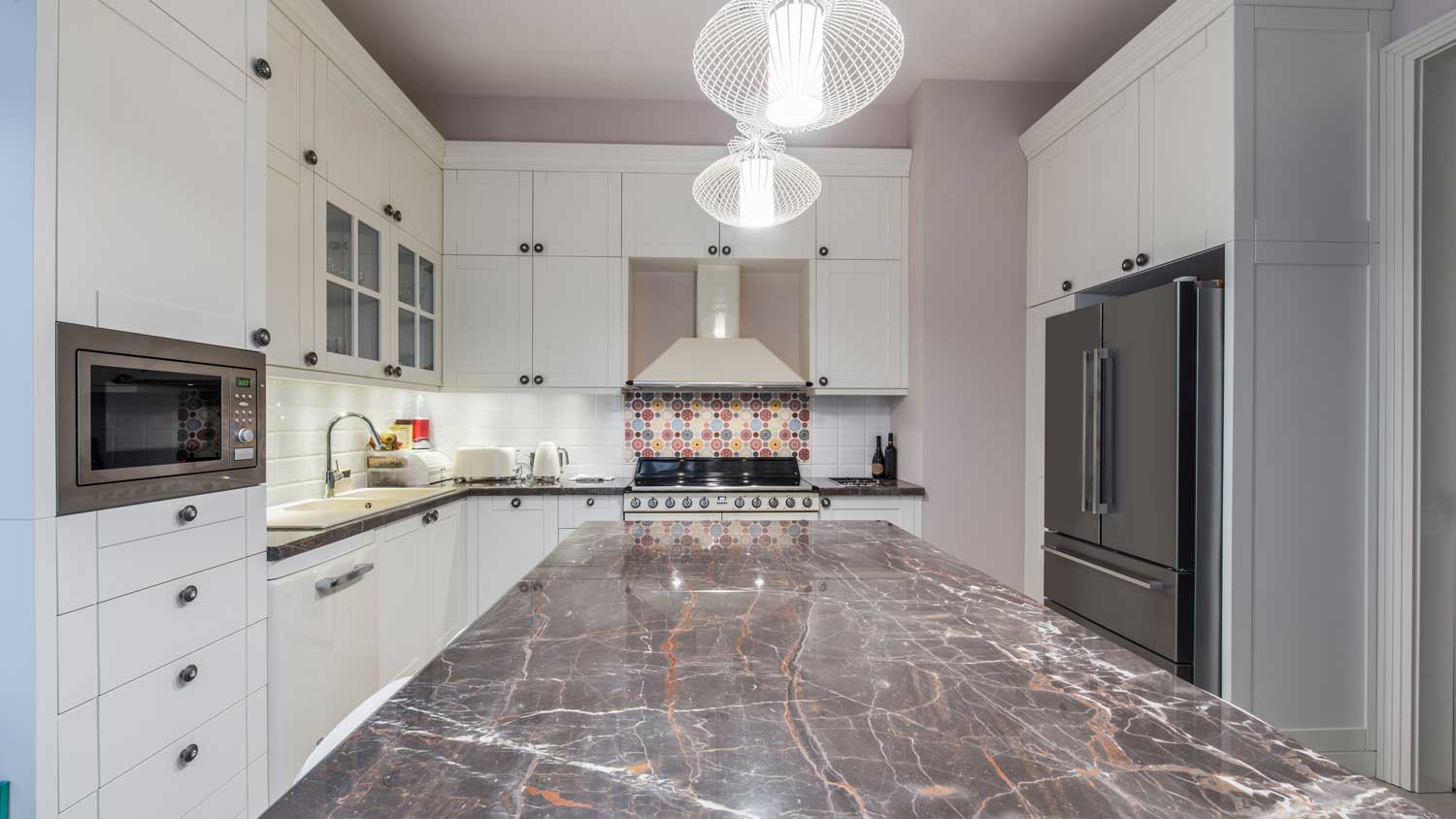How to Cut a Sink Hole in a Laminate Countertop
Slice through the mysteries of laminate countertop cutting


- Utility knife
- Tape measure
- Pencil
- Carpenter’s square
- Jigsaw
- Sink (optional)
- Laminate countertop (optional)
- Large sheet of paper
- Painter’s tape
- Two screws, any size
Whether you’re installing a new sink or doing a complete kitchen remodel, there are many reasons you may need to know how to cut a sink hole in a laminate countertop. This project requires a little DIY experience, but it’s not a project that’s not so difficult that a beginner with a few projects under their belt can’t handle it. Whether you’re installing Formica or another brand of laminate, you can use these steps for an attractive upgrade on a budget.
Prepping to Cut a Sink Hole in Laminate
Before jumping into how to cut a laminate countertop, you need the sink you will install. If you're buying a new sink, get the shopping and shipping (if needed) out of the way before your first cut. If you’re installing a new sink, it should come with a paper template, eliminating the need for step one. However, if you’re installing your old sink or a floor model whose template is long gone, be ready to create your own.
The last part of preparation for cutting laminate for a sink is stabilizing the laminate before drawing and cutting. If you’re cutting an installed countertop, check the cabinets to ensure they’re secure and sturdy. If you’re using sawhorses, ensure the laminate is secured with clamps so it doesn’t bounce or move during cutting.
Create a Template (Old or Floor Model Sinks Only)
Place a large piece of butcher or craft paper over the sink opening and pull the paper down over the edges. Tape down the paper with painter’s tape. Use a sharp utility knife to cut around the inside edges of the sink to create a template.
If you’re replacing an old countertop but keeping the sink, you can use the sink hole in the old countertop to create a template by tracing the outline. No matter your method, check the template's dimensions against the sink opening measurements.
Measure and Mark the Position Of The Sink
 Photo: Zephyr18 / iStock / Getty Images Plus / Getty Images
Photo: Zephyr18 / iStock / Getty Images Plus / Getty ImagesMeasure the template’s length and width. Using those measurements, mark with a pencil or pen the approximate position of the sink on the countertop. For example, if the sink needs to be five inches from the left edge, mark five inches from the left edge of the countertop. Create several marks along this edge and use a straight edge to create a guideline that shows where the left edge of the sink will go and where you will cut. Then, add the length of the sink to those marks to mark the right edge.
When marking the sink’s position, leave at least 1 ½ inches between the front of the sink and the front edge of the countertop. Leave enough space, usually 1 ¼ to 1 ½ inches from the back. Ensure enough space between the backsplash and the cut line for a jigsaw to fit.
Cover the Guidelines with Painter’s Tape
Trace the template onto the painter’s tape by placing the painter’s tape over the guidelines. (You may have to place several strips if the painter’s tape is narrow.) Put the template over the painter’s tape, use a carpenter’s square to align the template with your guidelines, and ensure the sink is square. Use small pieces of painter’s tape to hold the template in place.
Trace the Template
Use a pencil, pen, or felt tip pen to outline the template, transferring it to the painter’s tape. Use a measuring tape to check that your measurements match the sink's. (You can never measure too much.) Remove the template, leaving behind the shape of the template on the painter’s tape.
Cut a Hole Near the Template Line
Use a drill fit with a ½-inch spade bit to cut a hole in the laminate inside the guidelines. The hole should barely touch the guideline.
Cut Along the Template Line
 Photo: photovs / iStock / Getty Images Plus / Getty Images
Photo: photovs / iStock / Getty Images Plus / Getty ImagesPut a carbide laminate-cutting blade on your jigsaw. These blades have fine, horizontal teeth less likely to chip the laminate. Place the blade through the hole you just made, and cut along the cut line. Stop when you’ve cut just under halfway around the sink hole.
Support Waste Laminate and Finish Cutting
Use a scrap piece of two-by-four that’s just longer than the length or width of the sink. Place it over the unfinished sink hole. Use a drill and two screws to attach the wood to the waste piece of laminate you’re creating. The wood will support the waste and prevent its weight from snapping off and chipping the laminate as you near the complete cut.
Finish cutting around the hole.
Dry Fit the Sink
 Photo: BanksPhotos / iStock / Getty Images Plus / Getty Images
Photo: BanksPhotos / iStock / Getty Images Plus / Getty ImagesLift out the waste laminate. Brush off any dust, dry fit the sink by gently placing it in the hole. If the fit is too tight, use a belt sander, wood file, or sandpaper to smooth out rough areas and gradually make more space. Keep sanding or filing until the sink can fit the hole without getting stuck or bound in the countertop.
Put the Sink In, Mark, and Cut the Faucet Location (Optional)
You may or may not need this step, depending on the sink design. Once you’ve fit the sink, place it inside the hole. If there’s a faucet hole, mark it on the painter’s tape that should still be on the countertop. Use a spade bit of the appropriate size and drill the faucet hole.
Clean and Dry the Laminate
Take the sink out of the hole. Remove the painter’s tape. Wipe off any dust or adhesive from the painter’s tape, and you’re done.
DIY vs. Hiring a Pro
This project isn’t complicated, but it takes patience and precision. Most beginners with a few projects’ worth of experience can probably handle it. However, you’ll need to factor in the cost of the sink and laminate. The average new sink costs $400, while laminate costs $35 per square foot. Depending on the countertop size and sink model, these two factors can drastically change the project's price.
You might want to contact a pro if the project requires more than basic laminate cutting. On average, you’ll pay $430 for sink installation costs plus the cost of labor. Working with a local countertop installer may also include the cost of removing the old sink/countertop, plumbing updates, and faucet installation.
Frequently Asked Questions
The best blades for cutting laminate are carbide laminate-cutting blades. These blades have horizontal teeth rather than teeth that point upward and cut on the upward stroke. Cutting on the upward stroke, which is how wood blades work, can chip the laminate. Laminate-cutting blades also tend to have more teeth than wood blades, reducing the chances of chipping the countertop.
First, use the right blade, which we’ve already discussed. However, there are other ways to prevent chipping, such as using painter’s tape to mark the edges. It creates a clear, easy-to-see line. Cutting from the top down can also prevent chipping when using a blade with horizontal teeth. You may also want to cut from the back of the laminate sheet toward you to better stay on the line and keep your speed consistent.















